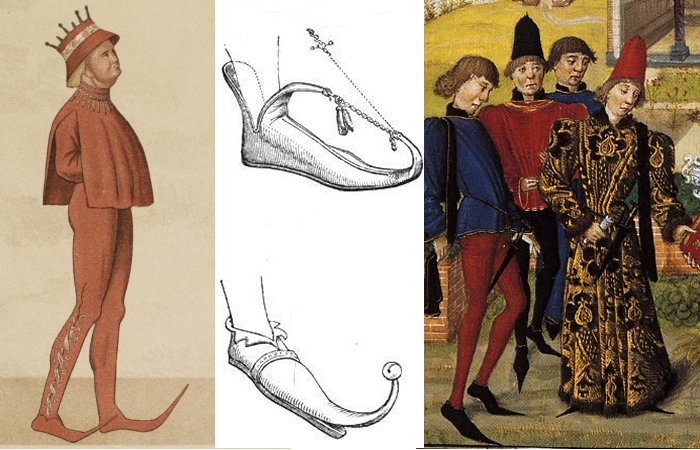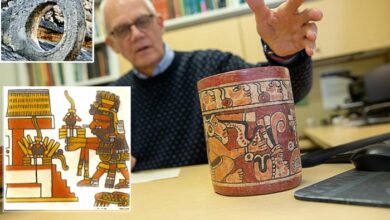Why Were Uncomfortable Poulaines High Fashion During The Middle Ages?

Conny Waters – AncientPages.com – You have probably seen people wearing shoes with extremely long toes in many Medieval paintings. These pointed shoes, whose tips could extend from just a few inches to well over two feet, were called poulaines. They were high fashion during the Middle Ages and were also referred to by other names such as pigache, pike, or crakow.
Left: Christopher of Bavaria (1416-1448) wearing poulines. Middle: Meyers Konversationslexikon 1888-1889 – Public Domain. Right: Poulaines worn in Burgundy c. 1470. Credit: Guillebert de Lannoy, c. 1468-70. Public Domain
The design of this particular style of shoe can be traced back to the 12th century. However, it did not become widely popular until the 14th-15th centuries. This was largely due to Crusaders who introduced various types of Hittite and Akkadian footwear upon their return to Western Europe from the Orient. These designs were distinguished by their elongated forms that culminated in subtle points. 1
Poulaines Were Controversial And Faced Criticism
This unusual footwear was painful to walk and made it almost impossible to perform manual labor because that type of work required one to be able to move without difficulty.
The Church detested poulaines and some of Europe’s most powerful kings banned them. Nevertheless, wealthy Medieval individuals kept proudly wearing their pinpointed shoes because they were a symbol of wealth and high status.
“Ever since even before Roman times, footwear has held a strong symbolic weight, representing the social standing and wealth of its wearer for all to witness.
By the late Middle Ages in Europe, shoes had evolved into a cornerstone of fashionable ornamentation, especially in circles where the practicalities of daily work and unobstructed movement gave way to more sumptuous priorities of conspicuous consumption and an appreciation for fine materials and craftsmanship, much to the disdain of the church.” 2
Poulaines were the subject of scorn from poets and historians and subjected to criticism by the clergy, who likened them to the tails of scorpions and horns of rams. Contemporary Italian scholars dubbed the shoes “devil’s claws.
Poulaines Deformed The Foot
A study by scholars at the University of Cambridge revealed that using pointed shoes was exceedingly discomforting. The investigation, which involved 177 skeletons from the 14th century, indicated that 27 percent of these individuals had malformed and twisted feet. Prior to the popularity of pointed footwear, this percentage was a mere six percent.
A study “conducted on a skeletal assemblage in Ipswich, England identified changes in the prevalence rate of hallux valgus, an excessive lateral angulation of the great toe relative to the first metatarsal, that corresponded to the wearing of pointed shoes.
A pinpointed shoe kept at the Frankfurt Museum, Germany. Credit: Public Domain
Although a range of factors can predispose an individual to hallux valgus including genetics, congenital structural variations in the alignment of the metatarsals, and muscle imbalance, the most common cause is wearing tight, ill-fitting footwear with a pointed toe-box. Constrictive shoes cause this condition by exerting a laterally directed force against the medial aspect of the hallux,” the scientists wrote in their paper. 3
As time passed, “the two-feet long poulaines were succeeded by duck-bills, the toes being so shaped, but still four or five fingers’ breadth in length, and that subsequently slippers were worn so very broad in front as to exceed the measure of a good foot.
This latter fashion does not appear to have found favor in Italy, where the poulaines, however, had been worn as generally as in Northern Europe.” 4
In the end, poulaines fell out of fashion in the 1480s.
Written by Conny Waters – AncientPages.com Staff Writer
Copyright © AncientPages.com All rights reserved. This material may not be published, broadcast, rewritten or redistributed in whole or part without the express written permission of AncientPages.com
Expand for references
- Marie-Josephe Bossan – The Art of the Shoe
- Babor, Matthew. “Devil’s Claws”: Phallic and Other Symbolisms of Poulaine Shoes, 12th-15th Centuries. Sound Ideas, 2022
- Jenna M. Dittmar, Piers D. Mitchell, Craig Cessford, Sarah A. Inskip, John E. Robb, Fancy shoes and painful feet: Hallux valgus and fracture risk in medieval Cambridge, England, International Journal of Paleopathology, Volume 35, 2021, Pages 90-100, ISSN 1879-9817, https://doi.org/10.1016/j.ijpp.2021.04.012.
- James Robinson Planché – A Cyclopaedia of Costume Or Dictionary of Dress, Including Notices of Contemporaneous Fashions on the Continent: The dictionary






